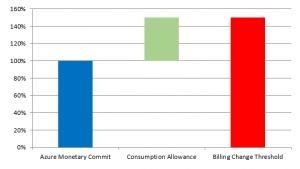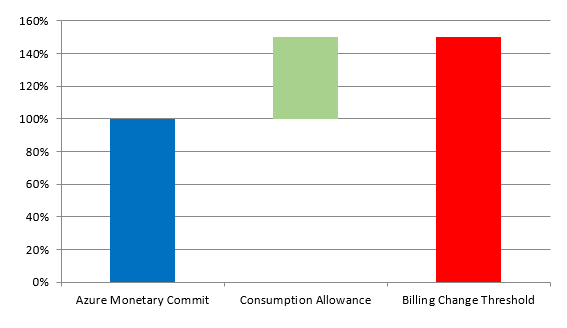- Erik Bullard
- Reading Time: 3 minutes

When an enterprise decides to adopt Microsoft’s Azure, they typically make an upfront financial commitment to Microsoft known as an Azure Monetary Commitment.
Seems simple enough, right? Determine the cost up front, followed by a period of complete freedom for designing, building, deploying and managing applications. If only it were that simple.
Please listen to our recent podcast highlighting some major changes as of May 2018
If your organization decided to move forward with Azure, did Microsoft fully explain how the Azure Monetary Commitment fee was determined? Did Microsoft walk you through how they derived the quantity of Azure Monetary Commitment units that appear in your proposal and resulting Customer Price Sheet (CPS)?
While many organizations understand the technical components associated with moving to Azure, there is almost always a lack of sufficient understanding when it comes to the upfront and downstream financial implications. Without a proper foundation of understanding and transparency, your organization can wind up overcommitting or even shelling out significant unplanned dollars.
What you need to know
The Azure Monetary Commitment is exactly what you might think from hearing the term — it is a revenue commitment that an organization makes to Microsoft. The commitment goes no further than that — it does not allow your organization unlimited usage. Even better for Microsoft, this commitment is non-refundable and not cancelable. You can’t walk away until your term is up.
In fact, the commitment value is essentially a pool of dollars that is consumed as your organization uses particular Azure services and thus draws on that pool. For example, if you are using a Streaming Unit with a consumption rate of $0.11/hour, after 10 hours of usage $1.10 will be drawn from your commitment pool.
- What do your consumption rates look like?
- Do you have a list of the costs for each Azure service that your organization is using?
In our experience, most Microsoft customers aren’t given the proper level of transparency and understanding and thus, they are at a significant disadvantage.
- Has Microsoft surprised you with an inflated bill at the end of the year, or better yet, did you receive a bill earlier than expected?
The amount of consumption can actually change your billing terms related to Azure services!
If the last sentence was not a surprise to you, you may already know about consumption allowance. Microsoft’s consumption allowance is a pool of dollars equal to 50% of your organization’s monetary commitment value. This 50% is added to your commitment as a placeholder for billing changes (i.e., 150% becomes the threshold for billing changes).

In the event that your organization’s consumption exceeds the Monetary Commit, as long as the annual consumption is under the allowance amount (150%), any overage is treated like a true-up that will be billed on an annual basis. If at any point the consumption exceeds 150%, billing for these services is switched to quarterly and your organization will be required to pay unexpected consumption overages in-term.
Key Takeaways
If your organization is a Microsoft Azure customer, chances are you had an uninformed start to this relationship. In many instances, Azure is just another line item that Microsoft will push to have tossed into the final deal, sometimes with a small dollar amount attached.
By taking this casual introduction, or even when Azure is the focal point, often many customers don’t even know what they are actually subscribing to and how the subscription even works. This is why it is so important that a full understanding is obtained at the outset — an understanding that includes, at a minimum, the proper level of price transparency and downstream price certainty.
For current Azure customers, given the lack of upfront transparency Microsoft willingly provides, it becomes very difficult to right size the relationship at renewal. It is not only important to ask Microsoft for more clarity, it is vital that your organization asks the right questions and receives the proper answers.
Related Blogs
SaaS Price Increases: What If Vendors Only Charged More When You Got More?
Microsoft Ends EA Volume Discounts: What It Means and How to Respond
Hyperscaler Renewals: Strategic Takeaways for CIOs and Infrastructure Leaders
About the Author
